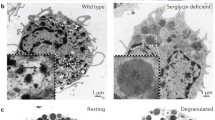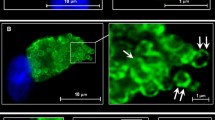Abstract
When isolated guinea pig major basic protein (MBP) was applied to SDS-PAGE, it exhibited a single band with an apparent molecular weight of 11000. When rat peritoneal mast cells were exposed to MBP at concentrations higher than 0.3 μM, significant histamine release was elicited both in the presence and absence of extracellular Ca2+. The histamine releasing activity of MBP was more pronounced in a Ca-free medium than in the presence of Ca2+. When MBP was applied on reverse phase HPLC, two distinct peaks were observed. These two proteins exhibited identical molecular weights and pI values. Their amino acid compositions were very similar. It was therefore assumed that guinea pig MBP is composed of two subtypes, namely GMBP1 and GMBP2, and that both have similar histamine releasing activities. MBP elicited not only45Ca uptake from the extracellular medium but also induced Ca2+ release from intracellular Ca stores.
Similar content being viewed by others
References
G. H. Ayars, L. C. Altman, G. J. Gleich, D. A. Loegering and C. B. Baker,Eosinophil- and eosinophil granule-mediated pneumocyte injury. J. Allergy Clin. Immunol.76, 595–604 (1985).
L. M. Zheutlin, S. J. Ackerman, G. J. Gleich and L. L. Thomas,Stimulation of basophil and rat mast cell histamine release by eosinophil granule-derived cationic proteins. J. Immunol.133, 2180–2185 (1984).
G. J. Gleich, N. A. Flavahan, T. Fujisawa and P. M. Vanhoutte,The eosinophil as a mediator of damage to respiratory epithelium: A model for bronchial hyperreactivity. J. Allergy Clin. Immunol.81, 776–781 (1988).
K. Tasaka, M. Akagi, M. Mio, K. Miyoshi and N. Nakaya,Inhibitory effects of oxatomide on intracellular Ca mobilization, Ca uptake and histamine release, using rat peritoneal mast cells. Int. Arch. Allergy Appl. Immunol.83, 348–353 (1987).
R. L. Barker, G. J. Gleich and L. R. Pease,Acidic precursor revealed in human eosinophil granule major basic protein cDNA. J. Exp. Med.168, 1493–1498 (1988).
K. Tasaka, M. Mio, M. Akagi and T. Saito,Histamine release induced by histone and related morphological changes in mast cells. Agents and Actions30, 114–117 (1990).
M. Ennis, G. Atkinson and F. L. Pearce,Inhibition of histamine release induced by compound 48/80 and peptide 401 in the presence and absence of calcium. Implications for the mode of action of antiallergic compounds. Agents and Actions10, 222–228 (1980).
C. M. S. Fewtrell, J. C. Foreman, C. C. Jordan, P. Oehme, H. Renner, and J. M. Stewart,The effects of substance P on histamine and 5-hydroxytryptamine release in the rat. J. Physiol.330, 393–411 (1982).
Author information
Authors and Affiliations
Rights and permissions
About this article
Cite this article
Tasaka, K., Mio, M., Aoki, I. et al. Guinea pig eosinophil major basic protein (GMBP) as a potent histamine releaser. (I) Histamine releasing activity of GMBP and its chemical structure. Agents and Actions 36 (Suppl 2), C242–C245 (1992). https://doi.org/10.1007/BF01997341
Issue Date:
DOI: https://doi.org/10.1007/BF01997341




